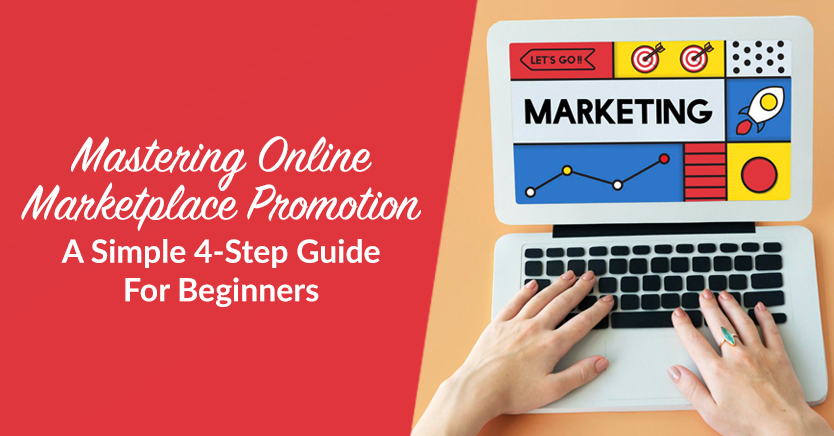
Why is online marketplace promotion important? For a new e-commerce business, crafting an exceptional website is only part of the equation. The other is spreading awareness about your store to boost sales. Thus, relying solely on a website won’t suffice.
By tapping into various digital marketing techniques like SEO, social media marketing, content strategies, and Pay-Per-Click, you can connect with potential customers. You can show your vendors that your marketplace caters to their needs and that it is a trustworthy platform for transactions.
In addition, many of us today are glued to digital content through our gadgets, relying on the internet for nearly everything. Furthermore, the recent pandemic has made online shopping the norm.
All these reasons highlight the significance of marketing through digital channels. Thus, it’s essential for every new marketplace owner to create a solid plan that incorporates marketing.
Today, we aim to explore four simple yet extremely powerful digital marketing strategies sure to benefit your e-commerce venture. So let’s dive in!

Initiating Your E-Commerce Journey: 4 Steps To Digital Marketing Success
If you’re new to the world of multi-vendor marketplaces, you need to master the following digital marketing steps:
- Create a solid plan
- Define your target market
- Determine your value proposition
- Start promoting your online marketplace
Doing so will help you avoid wasting time and money on things that won’t positively impact your sales. Let’s explore each of these in more detail.
1. Create a Solid Plan
Creating a robust plan is the foundational step when diving into the realm of multi-vendor marketplaces. Without it, everything from your online marketplace promotion to your other business strategies will lack direction.
Eager to craft an exceptional plan? Then consider the following elements:
Vision and Objectives
Outline your vision for the marketplace. What purpose does it serve? What are your long-term and short-term goals? These objectives will steer your marketing efforts and overall strategy.
Speaking of goals, ensure that they adhere to the SMART criteria:
- Specific: Clearly define what you aim to achieve with precise details. For example, you can say you want to increase monthly website traffic by 30% within the next six months.
- Measurable: Establish metrics to quantify your progress and success.
- Attainable: Set goals that are challenging yet within reach with effort and resources.
- Realistic: Ensure your goals align with the marketplace’s capabilities and resources available.
- Time-bound: Assign a timeframe to each goal, creating a sense of urgency and accountability.
For example, you can aim to increase monthly website traffic by 30% within the next six months – a goal and timeframe which, after considering your available resources and current growth trends, you discover to be realistic.
To accurately measure this increase, you can track website traffic using Google Analytics or similar tools. Then, you can make your objective attainable by implementing SEO optimization, content marketing, and targeted advertising.
Market Research
Conduct in-depth market research to understand online consumer behavior, competitor strategies, and compelling promotional tactics in the multi-vendor marketplace sphere. You should then use this knowledge as the basis for strategic decisions concerning your online marketplace promotion.

Platform and Technology
Select a platform and technology stack that optimizes promotional activities. Remember to evaluate options considering their capacity to support promotional integrations, user engagement features, and seamless vendor management.
Budget and Resources
Allocate a dedicated budget for promotional activities. Make sure you have sufficient resources for online advertising, targeted campaigns, promotional content creation, and other promotional initiatives crucial for marketplace growth.
Marketing Strategy
Develop a comprehensive marketing strategy catering to various digital channels, including social media, SEO, influencer collaborations, and content marketing. Craft compelling messaging aligned with unique value propositions to captivate the target audience.
Vendor Acquisition
Devise a strategic plan to entice vendors to join the marketplace, emphasizing promotional advantages, ease of access, and potential profitability. Moreover, highlight any promotional support that you’re offering to onboarded vendors.
Metrics and Evaluation
Establish key performance indicators (KPIs) to measure the success of your online marketplace promotion. Then, regularly monitor these metrics and be ready to adjust strategies based on the insights gained.
By crafting a detailed promotional plan that covers these elements, you lay a robust groundwork for effective and targeted online marketplace promotion. Thus, you foster the growth and success of your e-commerce venture.

2. Define Your Target Market
The next step is to figure out who’s your target market.
First, ask yourself what problem your products solve. Then, find people who are experiencing this problem. Once you understand your audience’s demographics and psychographics, you can craft more compelling, targeted marketing messages.
Here are several strategies that can help you pinpoint your ideal audience for effective online marketplace promotion:
Data Dive
Use digital analytics and market research tools to understand online consumer behavior. Specifically, look at demographics, interests, online habits, and purchasing patterns, as such data reveals your potential customers’ digital footprints.
Segmentation
Break down your audience into segments based on preferences, needs, and behaviors. Basically, this segmentation helps tailor your promotional strategies for maximum impact on specific groups.
Persona Creation
Craft detailed buyer personas representing your ideal customers. These fictional characters embody the traits, preferences, and pain points of your target market. Personas guide your promotional content to resonate deeply with the right audience.
Channel Alignment
Identify the digital platforms that your target market commonly uses. Whether it’s social media channels, specific websites, or online forums, being where your audience hangs out is crucial for impactful online marketplace promotion.
Feedback Loop
Engage with your audience. Listen to their feedback, reviews, and comments on social media and other platforms. This interaction provides invaluable insights for refining your promotional strategies.
By defining your target market in the online landscape, you gain a clear understanding of who you’re aiming your promotions at. This precision ensures that your marketing efforts hit the bull’s eye, resonating with the right audience and driving engagement in your multi-vendor marketplace.

3. Determine Your Value Proposition
One of the main reasons why people fail in e-commerce is because they haven’t figured out what makes their brand unique. Therefore, ask yourself: Why should people choose your product and not the competition‘s?
Your value proposition tells prospects why they should do business with you rather than your competitors. In addition, it highlights the benefits of your products or services from the outset. This will help you craft more effective marketing messages when communicating with your target audience.
Here’s how to figure out what sets your marketplace apart:
Solve the Puzzle
Your value proposition is the answer to your customers’ problems or needs. Therefore, identify what pain points your marketplace resolves or what unique offerings it brings to the table.
Stand Out in the Crowd
Explore what makes your marketplace different from the sea of options online. Is it exceptional customer service, a diverse range of products, unbeatable prices, or a seamless shopping experience? Highlight these distinguishing factors.
Customer-Centric Approach
Focus on benefits rather than just features. Thus, emphasize how your marketplace enhances the lives of your customers or simplifies their shopping experience. Show them the value they’ll gain by choosing your platform.
Clear and Concise Communication
Express your value proposition in a succinct and understandable manner. In other words, make sure your audience can easily grasp what you’re talking about. Think of it as a catchy tagline that sticks in their minds.
Test and Iterate
Once you’ve formulated your value proposition, put it to the test. Gather feedback from potential customers or run A/B tests on messaging to see what resonates best.
Crafting a compelling value proposition for your online marketplace is like presenting a captivating story – it draws people in and makes them eager to be a part of what you’re offering. It’s this uniqueness that sets the stage for successful promotion in the competitive digital landscape.

4. Start Promoting Your Marketplace
Create awareness about your marketplace by promoting it across digital marketing channels.
If you’re wondering where to start, here’s a little secret: Target your promotions where your audience is most active.
Digital Promotional Techniques
Since we’re talking about an internet-based business, you should harness the power of search engines to drive traffic to your multi-vendor marketplace. This means using SEO and other strategies that can make your platform more visible to anyone using the likes of Google and Yahoo when searching for products, information, and answers to questions.
Consider the following strategies, as they can propel your e-commerce business towards success:
- Facebook Campaigns: Target your audience with ads and engaging content on Facebook.
- Search Engine Advertising (Google & Bing Ads): Drive website traffic by bidding on relevant keywords in search results.
- Consistent Blogging: Attract and inform your audience by regularly posting valuable content on your blog.
- Email Marketing: Build relationships and boost conversions through targeted email marketing and newsletters.
- Chrome App Creation: Improve user experience with a customized Chrome app for your marketplace.
- Guest Posting: Expand your reach and credibility by contributing content to industry-related websites.
- Continuous SEO Efforts: Optimize your website to improve visibility in search engine results.
- Social Media Promotion: Increase your marketplace’s presence by engaging on social platforms and sharing relevant content.
Most e-commerce property owners employ every method all at once in hopes of growing fast. Unfortunately, this is not only time-consuming but likely to produce obscure results.
The better approach is to choose a limited number of ways to promote your online store. Therefore, focus your efforts on those channels and measure your results to see what’s working and what isn’t. Then, gradually expand and refine your efforts based on what’s driving growth and sales.
Moreover, remember that it takes time to build a solid online presence through search engines, create profitable Pay-Per-Click campaigns, or run successful social media campaigns. Thus, patience is key when implementing your online marketplace promotion.

Traditional Advertising Methods
While content, influencers, social media, and paid search are among the best ways to promote a new multi-vendor marketplace, don’t neglect offline methods of promotion. After all, an omnichannel marketing strategy is often more powerful than one that relies on one or a few channels only.
Consider traditional advertising techniques such as:
- Outdoor Advertising: Billboards, posters, and banners in high-traffic areas like highways and city centers for maximum visibility.
- Direct Mail: Sending promotional materials directly to mailboxes, such as postcards, catalogs, or letters.
- Telemarketing: Making phone calls to promote products or services directly to potential customers.
- Event Sponsorship: Supporting events, conferences, or sports teams to boost brand visibility.
- Public Relations (PR) Activities: Managing a company’s image through press releases, media relations, and community engagement.
- Print Advertising: Ads in newspapers, magazines, flyers, or brochures for broad public distribution.
- Television Commercials: Airing ads during TV programs to convey messages using visuals and audio.
- Radio Advertisements: Broadcasting ads on radio stations to reach targeted audiences through audio content.
These techniques were more popular before the internet. However, they continue to serve many companies today.
Budget Considerations
Don’t forget your budget when choosing a promotional channel. For cost-effective options, consider leveraging influencers, blogging, or email marketing. When aiming for broader reach, honing in on advertising profitability stands out as the most rewarding long-term strategy.

Conclusion
Online marketplace promotion is crucial if you want your new multi-vendor marketplace to attract customers and generate revenue.
To recap, to ensure your online marketplace promotion is sound, observe the following steps:
- Create a solid plan
- Define your target market
- Determine your value proposition
- Start promoting your online marketplace
Are you interested to know more about online marketplace promotion? Then reach out to us and let us know; we’d be happy to answer your questions!